Victor Victapen c. 1932 to 1949
by Jim Mamoulides, July 31, 2019, updated June 12, 2023
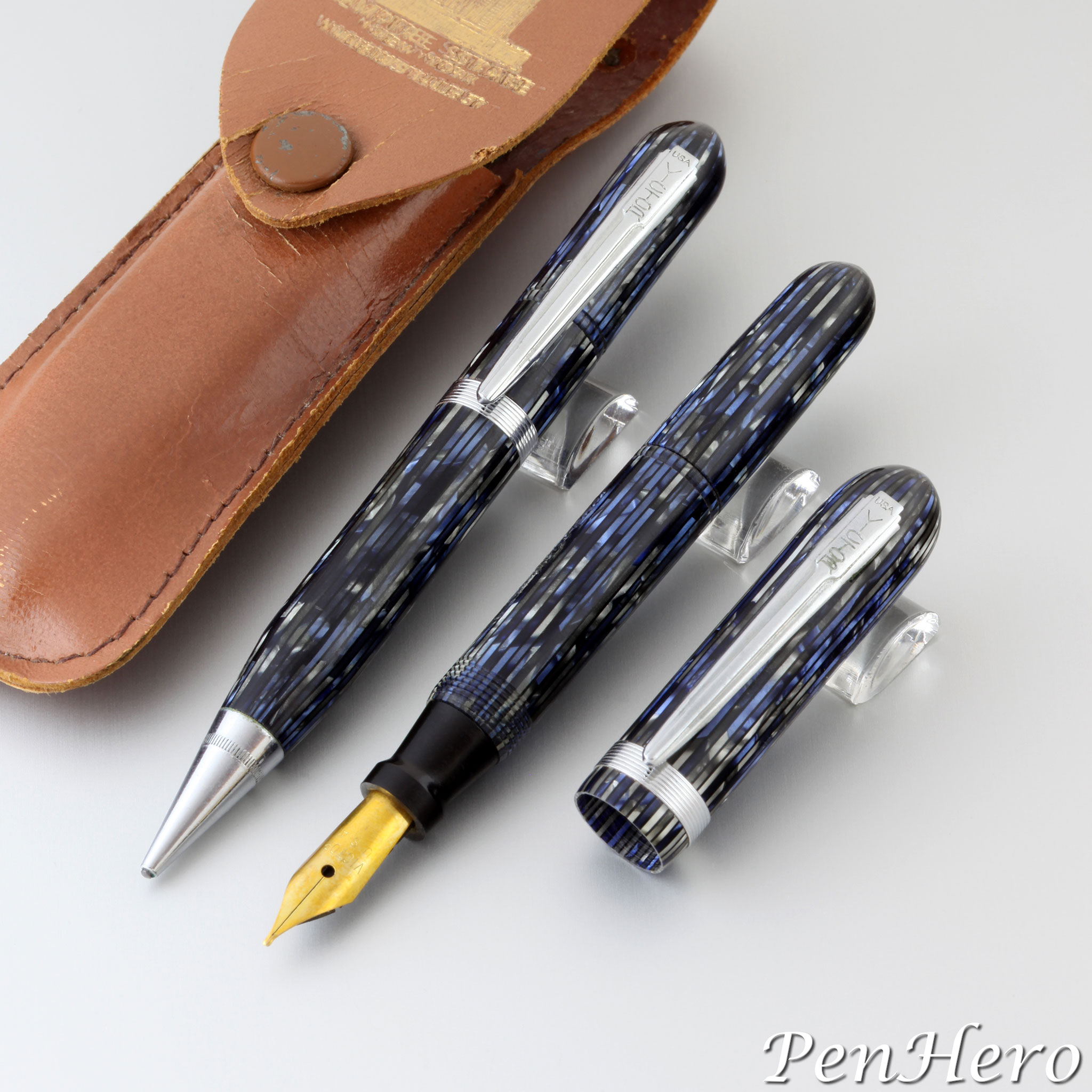 Victor Victapen fountain pen and pencil set in blue stripe c. 1945-1949 with case
Victor Victapen fountain pen and pencil set in blue stripe c. 1945-1949 with case
The Convertible Combo!
Pens made by the U. S. Victor Fountain Pen Company of New York, New York might be overlooked by many collectors. There aren’t a lot of Victor pens and pencils in circulation, and there is a distinct lack of catalogs, advertisements, and other primary sources to peruse for information. The company made many unremarkable conventional fountain pens and pencils for much of the first half of the 20th century except for two interesting, patented designs, both for compact writing instruments. The first was a collapsible telescoping ring-top fountain pen made c. 1919–22, and the other was a convertible compact pen and pencil set, c. 1932–1949, that could be reassembled into a full-length pen and pencil combo.
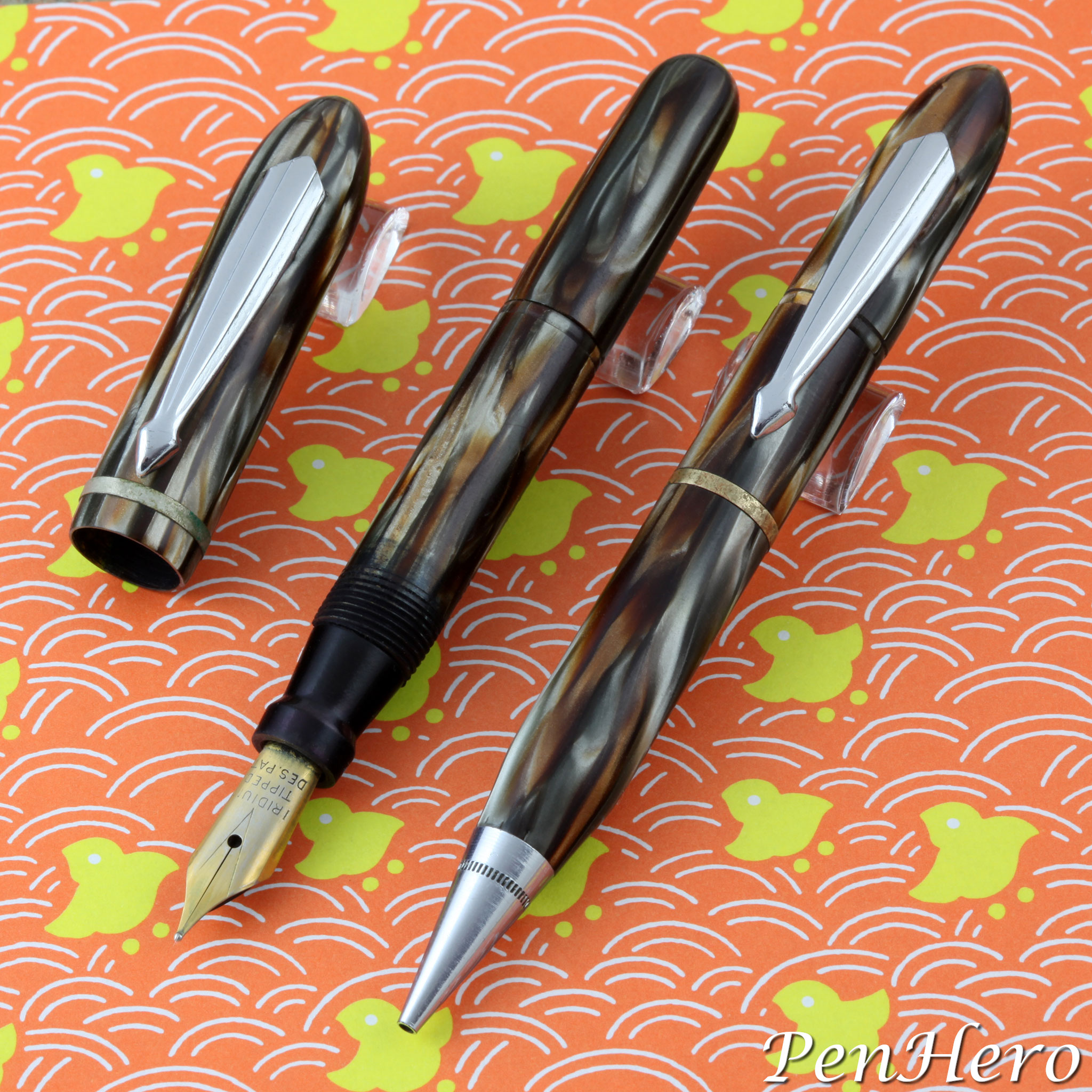 Victapen Convertible fountain pen and pencil set in rust marble c. 1932-1942
Victapen Convertible fountain pen and pencil set in rust marble c. 1932-1942
On May 11, 1932, Edward Hugetz, president of the U. S. Victor Fountain Pen Company, applied for a patent on a bulb-filling fountain pen with an ink sac designed to fill the entire barrel, tapering onto the section nipple. The sac has a narrowed middle neck designed to fit through the threaded end of the barrel, ending with a bulb that fills the end cap. US patent no. 1,918,844 was awarded on July 18, 1933, for the invention. The pen operates by unscrewing the end cap and squeezing the bulb end to fill. The design includes a breather tube extending from the back of the feed into the ink sac all the way to the thread for the barrel end cap. The breather tube allows for a more complete filling, expelling air as ink enters the ink sac. The company called this “System Edward Hugetz” in post World War II instructions included with the pen and pencil set.
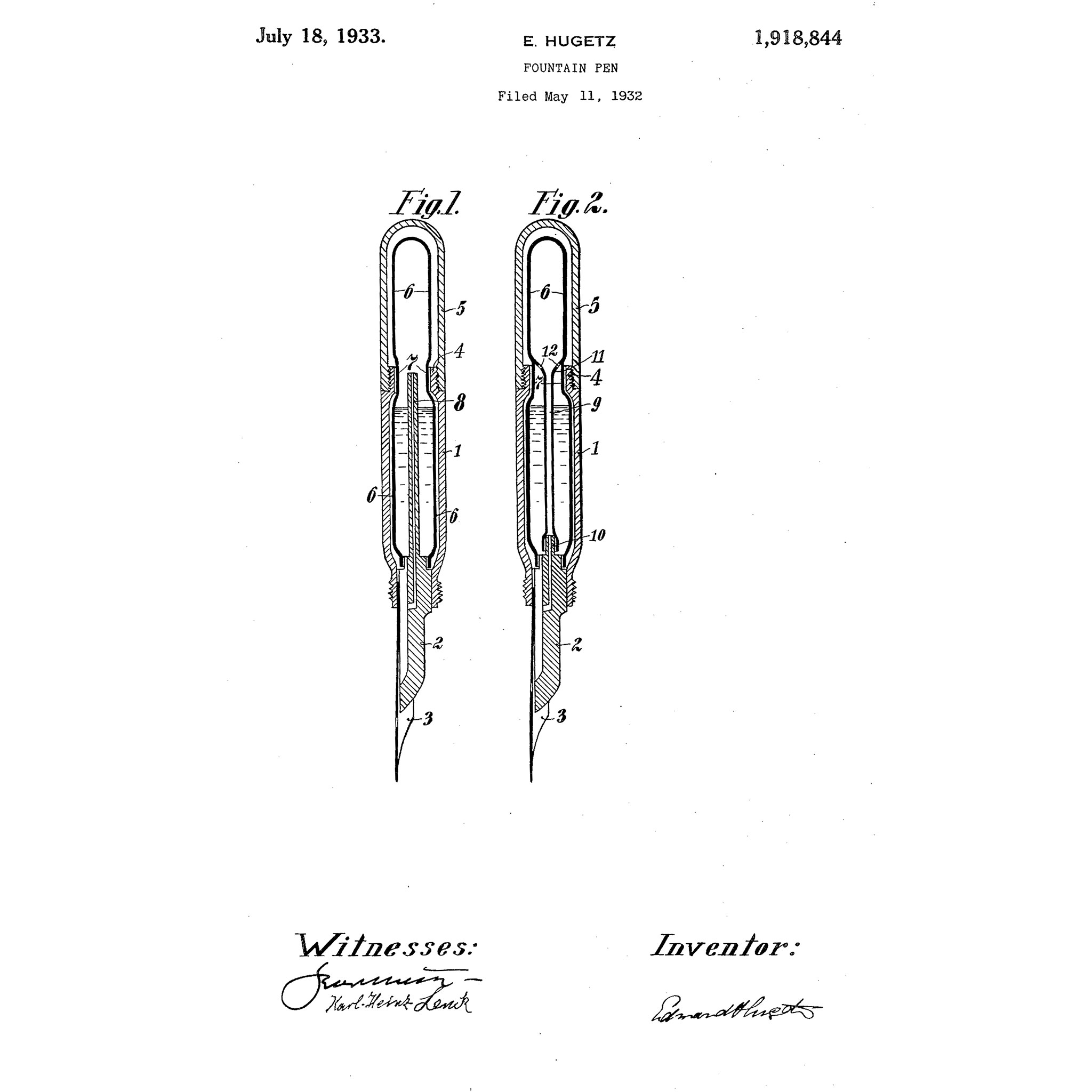 United States Patent 1,918,844, awarded on July 18, 1933
United States Patent 1,918,844, awarded on July 18, 1933
This patented design became the basis for the Victapen convertible fountain pen. The convertible feature was the owner could disassemble the pen and pencil by removing the pen’s end cap and pencil’s clip top and reassemble the parts into a 5 to 5 ½ inch long pen and pencil combo by putting the pencil point onto the end of the pen barrel. The pencil cap and pen barrel end cap could be put together for safe keeping. These small pens came in a variety of celluloids, including stripes, marbled colors, and dashed stripes. At least five clip designs are observed.
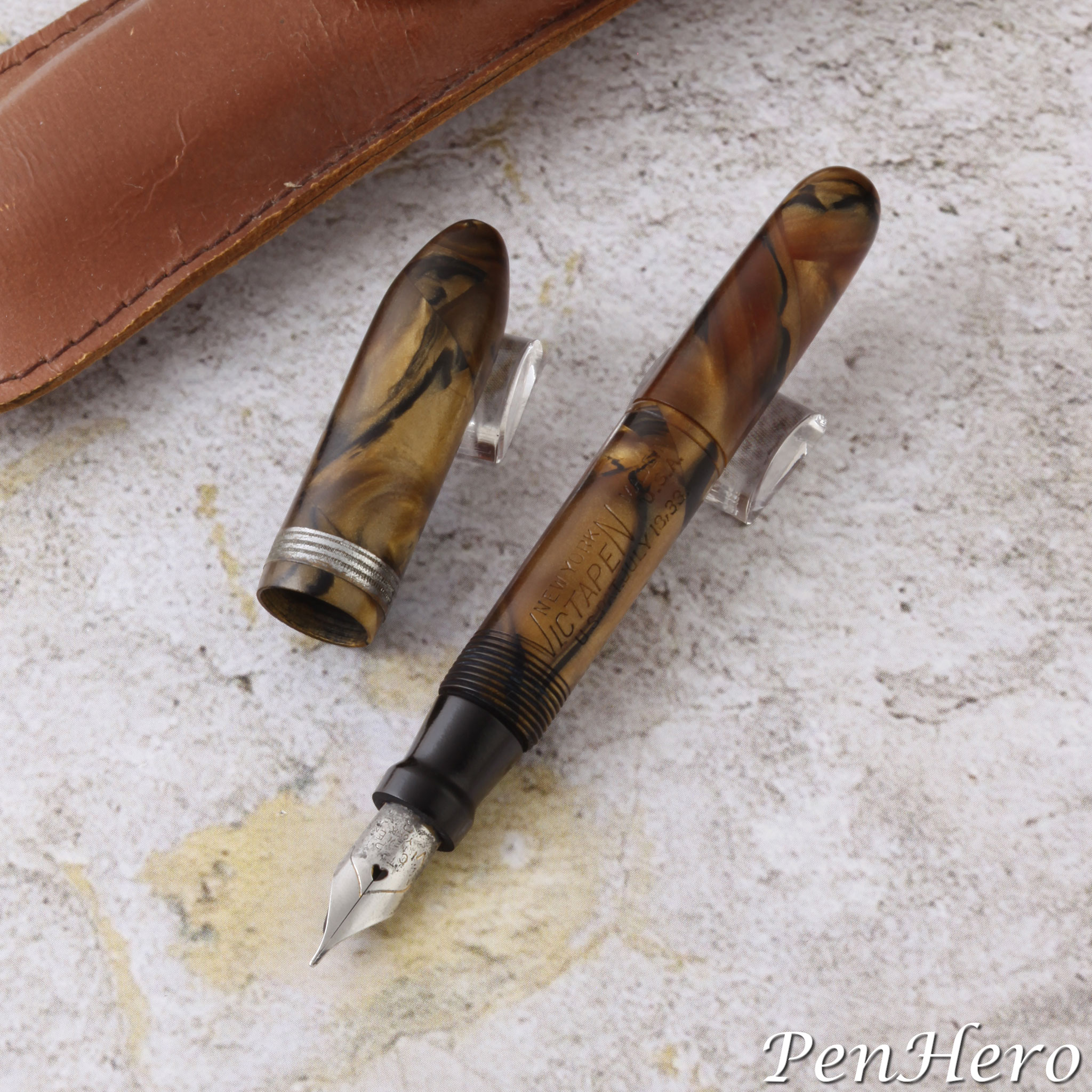 Victor Victapen ringtop fountain pen in brown marble c. 1932-1942, missing the ring clip
Victor Victapen ringtop fountain pen in brown marble c. 1932-1942, missing the ring clip
According to the instruction sheet included with post–World War II manufactured Victapens, the company says it did not produce pens during World War II, likely because, as with many manufacturing companies, it was pressed into to making wartime-required goods. I found a lack of company advertisements in 1943 and 1944 that appears to confirm that.
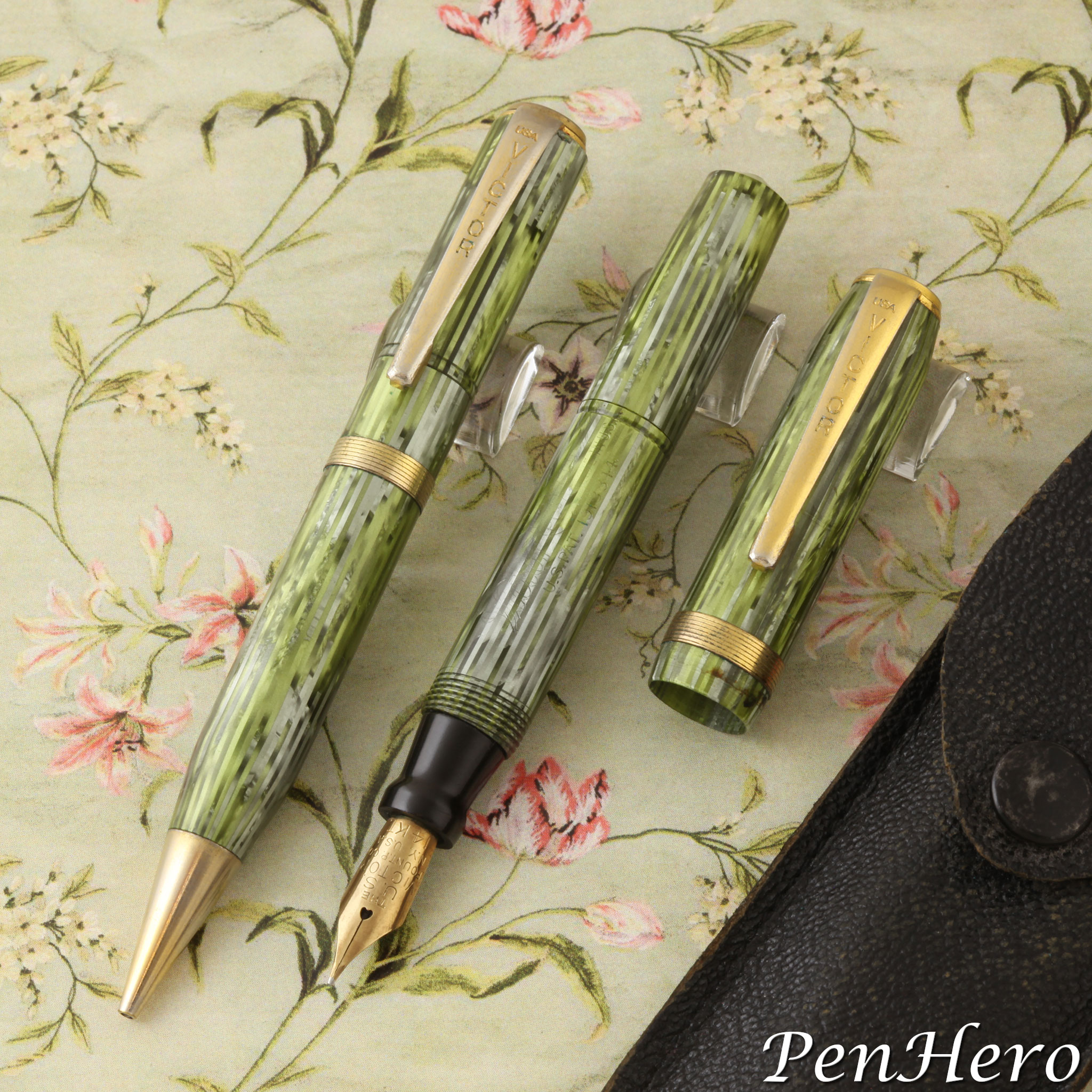 Victapen Convertible fountain pen and pencil set in spring green stripe c. 1945-1949
Victapen Convertible fountain pen and pencil set in spring green stripe c. 1945-1949
Company advertisements for the Victor brand and the Victapen can be found through at least 1949, with the latest company advertisement I could find in the Mennonite Weekly Review, on September 8, 1949. The company continued in business into the 1950s. Hugetz’s March 17, 1952, application for trademark 583,312, registered December 8, 1953, claims an updated Victor logo was in use on ballpoint pens and cartridges in December 1949.
Since the U. S. Victor Fountain Pen Company was a going concern for over fifteen years as of the May, 1932 patent application, I believe it’s possible that the first Victapens may have been made as early as that year. The company was seeking distributors for the newly patented pen by August, 1933 as seen in an advertisement in the Hartford Courant, and in many subsequent ads that year.
Identification Guide and Features
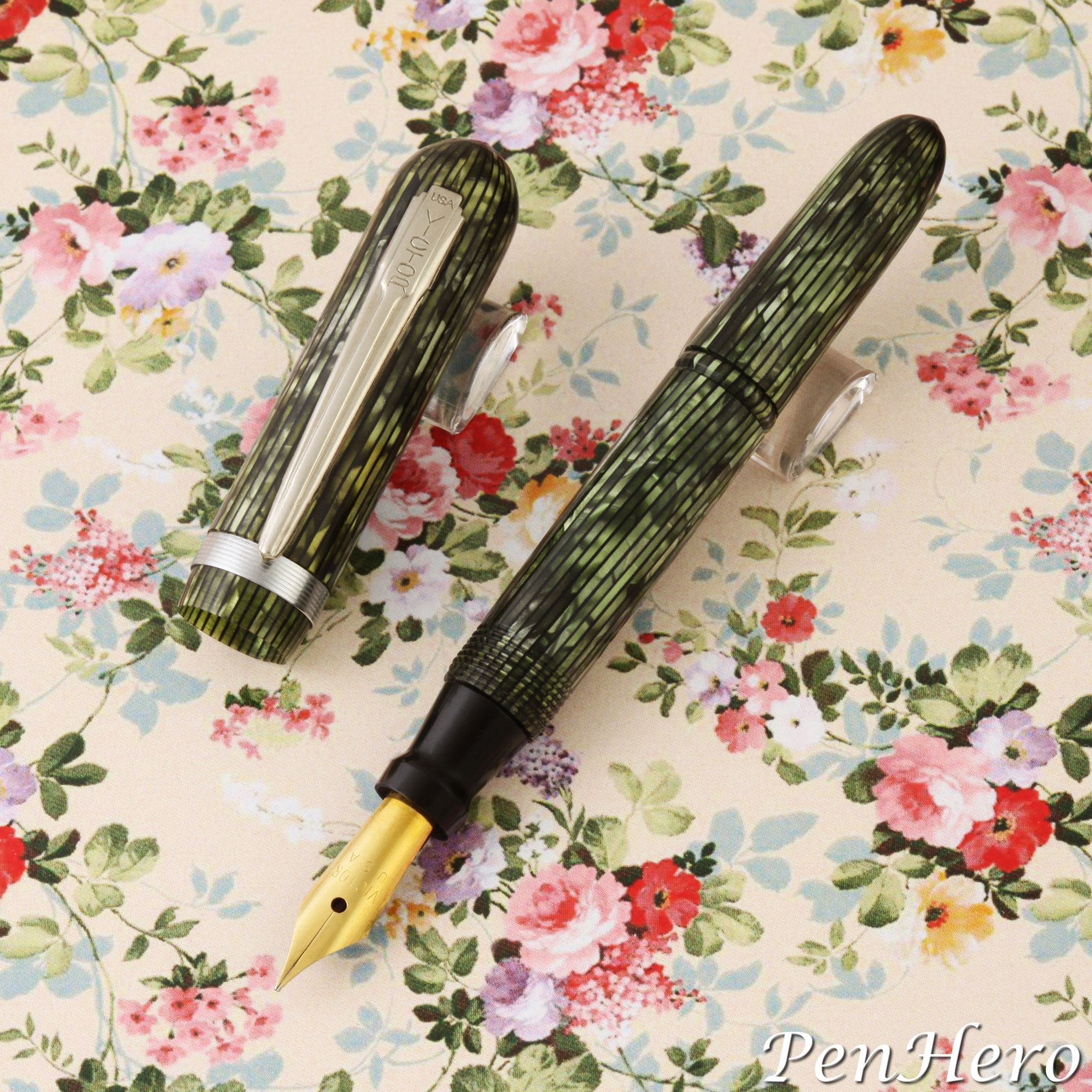 Victapen Convertible fountain pen in green stripe c. 1945-1949
Victapen Convertible fountain pen in green stripe c. 1945-1949
Most Victapens you will see are made of celluloid. An all gold-filled model existed, and the one known example is cylindrical, with bulleted ends and a rectangular version of an earlier Victor Collapsible Fountain Pen’s Square pattern engraving extending the length of the cap and barrel. It has ball-end clips on the pen and pencil caps, which suggest it dates to the early 1930s. It came in a leather presentation case, not an envelope type like the celluloid pens. It is not known if any other variations of all metal Victapens were made. I would really like to see and photograph one of these pens if a reader has one to loan.
Early Celluloid Victapen c. 1932–42
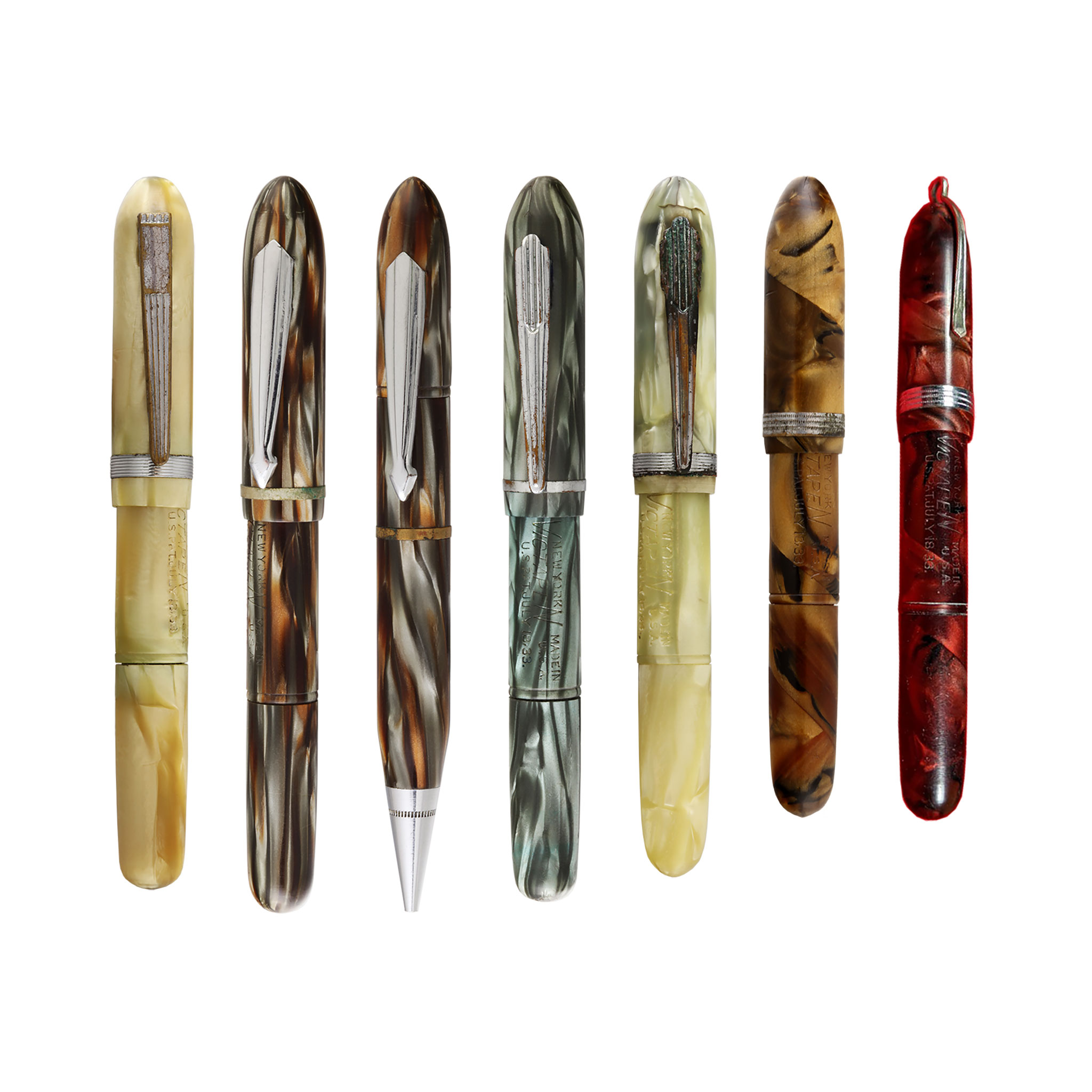 Early Celluloid Victapen Convertible fountain pens and pencil c. 1932-1942
Early Celluloid Victapen Convertible fountain pens and pencil c. 1932-1942
Early celluloid pens c. 1932–42 are observed with a cap and barrel in a variety of marbled colors. They will have a barrel imprint with NEW YORK over VICTAPEN next to MADE IN over U. S. A., all over U. S. PAT. JULY 18 ’33. It's possible that the striped models were introduced by the early 1940s, but I have seen no evidence in advertisements and have no catalogs that show striped Victapens by 1942. The few early ads that show Victapens only show marbled pens and the few later, post World War II ads and instruction sheets show striped pens. Therefore, I'm going to call the marbled ones "early" and the striped ones "late" until I get better information.
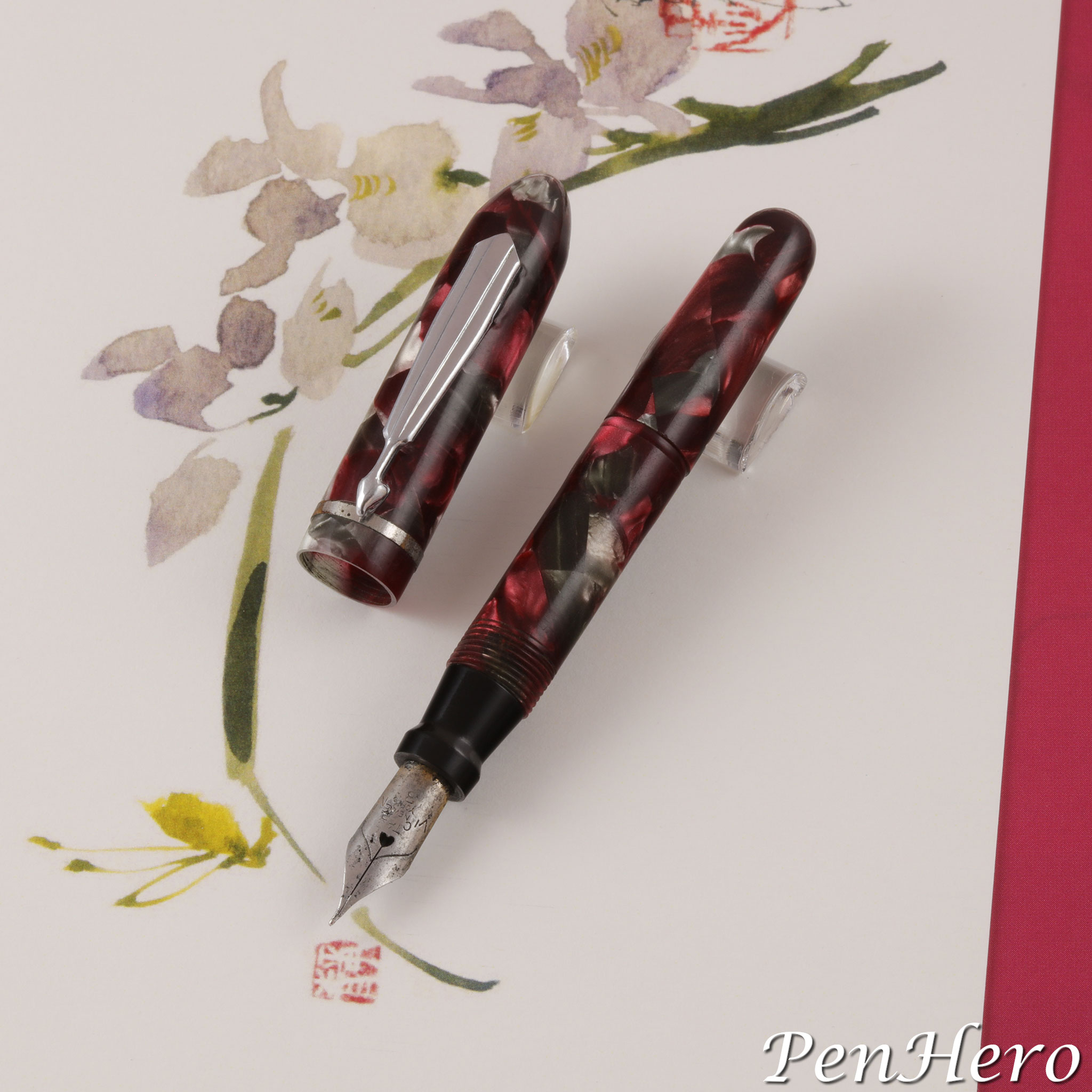 Smaller size Victapen Convertible fountain pen in rose and gray marble c. 1936-1942
Smaller size Victapen Convertible fountain pen in rose and gray marble c. 1936-1942
Advertised as a men’s vest pocket or ladies’ handbag pen set, these 3 13/16 to 4 inch long pens were sold in the 1930s as pen and pencil sets in stores for $1 or direct from the manufacturer by mail order (plus 10 cents postage) and included a personalized leather pen case.
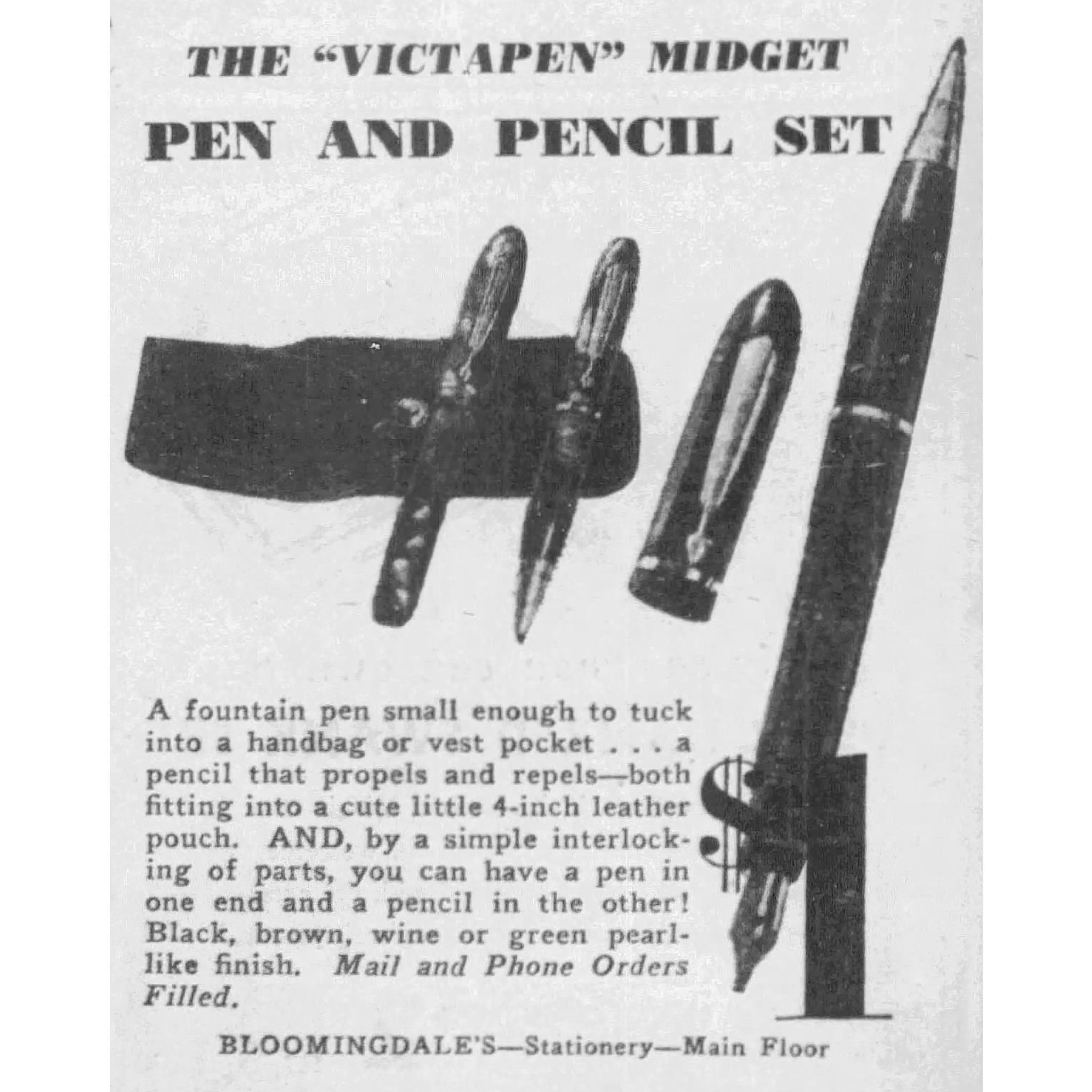 Advertisement, New York Daily News, December 22, 1936
Advertisement, New York Daily News, December 22, 1936
- Silver colored or gold-plated clip, with at least three designs including an over-the-top type with a loop for a watch chain
- Single cap band in a variety of designs plated to match the clip
- Threaded cap
- Gold-plated stainless steel nib with a V design stamped and patent marking, though other nib types have been found that may not be original
- Total nib grades unknown, but fine and medium are observed
- Bulb filler
- Two sizes, 3 13/16 inches and 4 inches long capped
- Retail price for the fountain pen and matching pencil set was $1 in 1936
Late Celluloid Victapen c. 1945–49
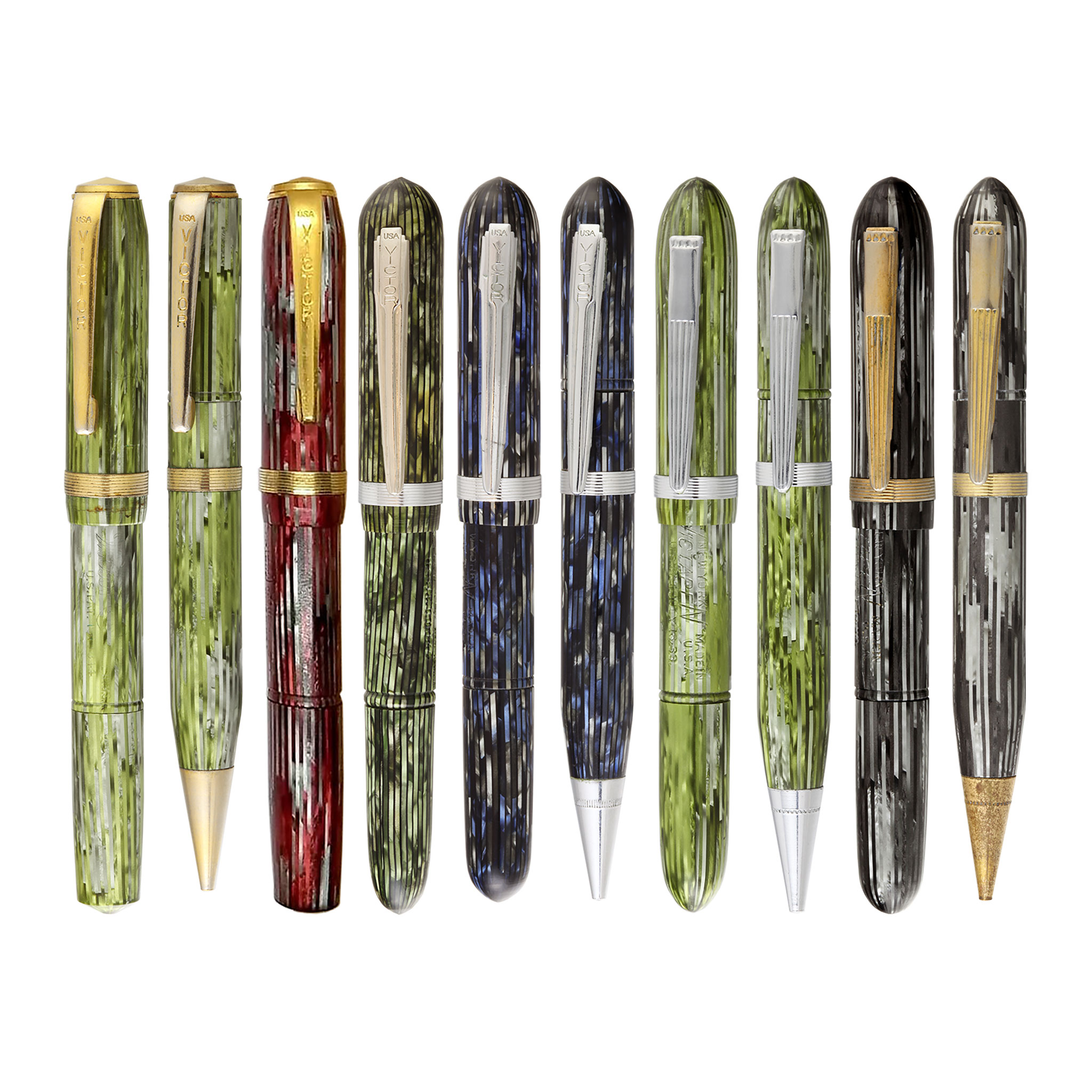 Later Celluloid Victapen Convertible fountain pens and pencils c. 1945-1949
Later Celluloid Victapen Convertible fountain pens and pencils c. 1945-1949
Late celluloid pens c. 1945–49 are consistently observed with a striped celluloid cap and barrel in blue, gray, red, spring green, and green. Other celluloids may be possible, but I have seen no such examples. They will have either the early barrel imprint or a later imprint with the Victor logo next to U.S.F.P.Co. (within an oval) next to REG. U.S. PAT. Over MADE IN U.S.A., all over U.S. PAT. 1918844. The one consistent design element on these later Victapens is the cap band. I've only seen striped pens in one size, all about 4 inches long capped.
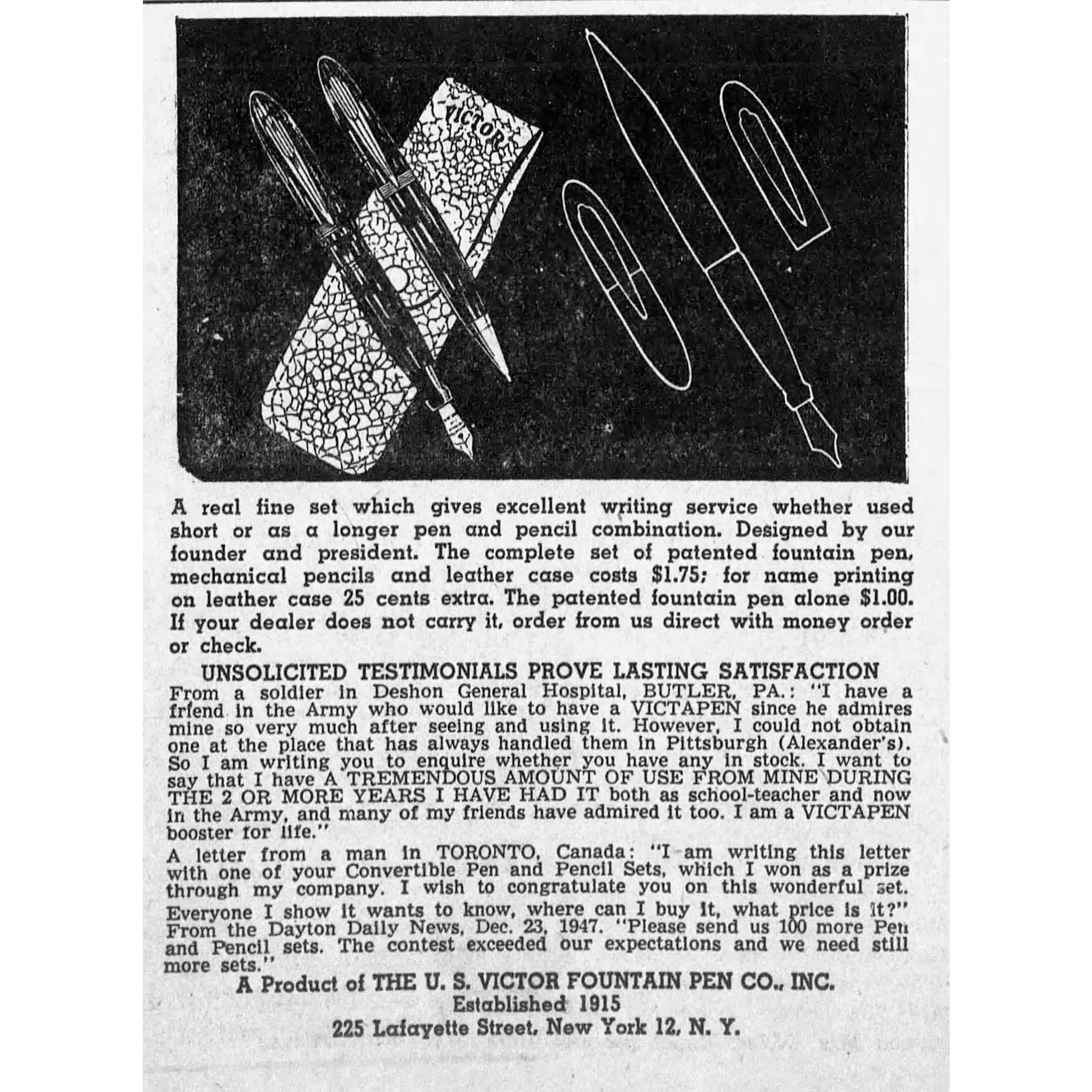 Advertisement, Mennonite Weekly Review, September 8, 1949
Advertisement, Mennonite Weekly Review, September 8, 1949
The latest company advertisement I could find was in the Mennonite Weekly Review, on September 8, 1949. The ad shows a striped Victapen pen and pencil set with a silhouette of them reassembled into a pen and pencil combo. The pen and pencil set with a leather case is offered for $1.75 and 25 cents additional for the owner’s name printed on the case. The pen alone is $1.00. This ad points the customer to their local retailer but also offers direct to consumer service.
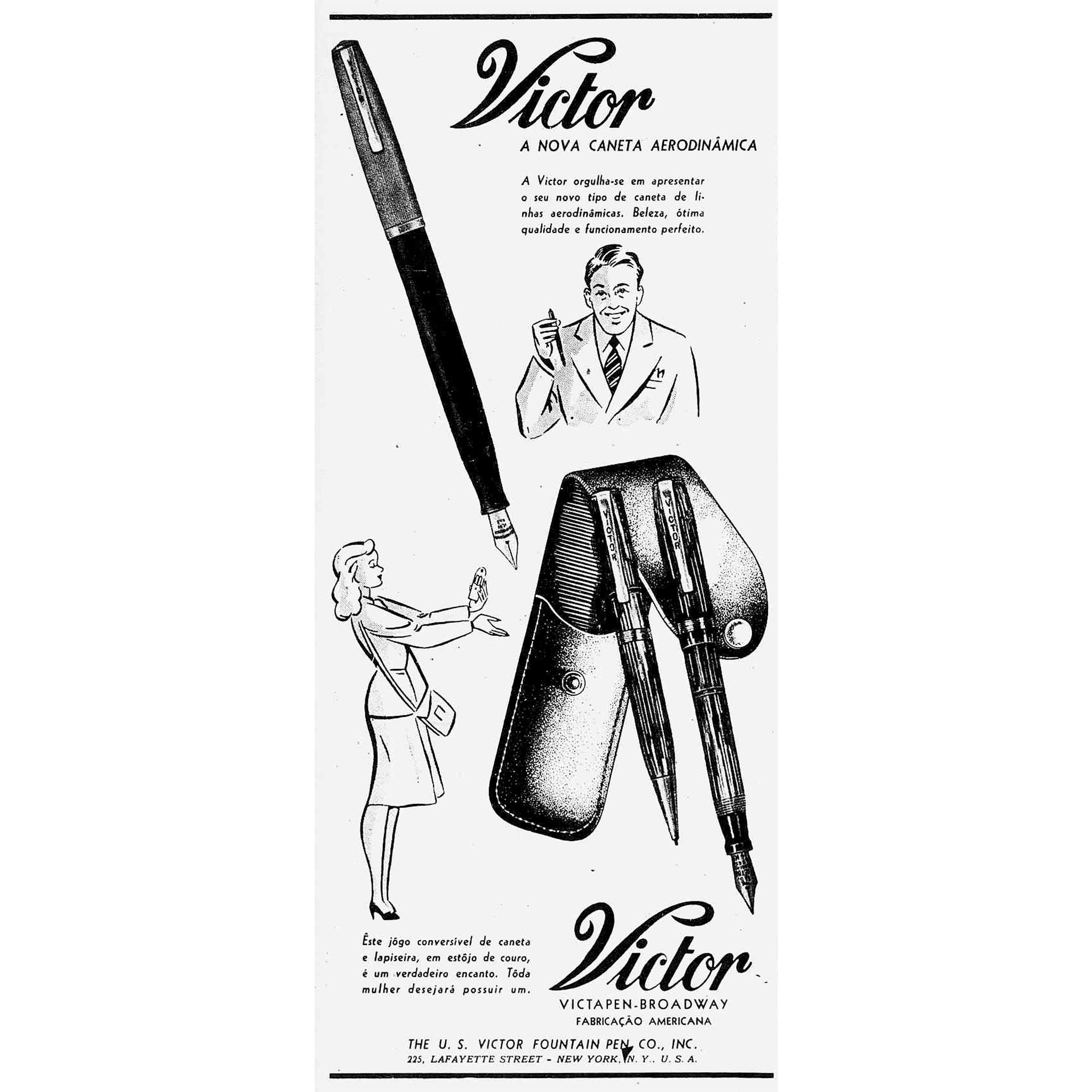 Advertisement, La Noite Ilustrada, Rio de Janeiro, Brazil, November 25, 1947
Advertisement, La Noite Ilustrada, Rio de Janeiro, Brazil, November 25, 1947
- Silver color or gold-plated clip, with at least four designs
- Single cap band with a ribbed design
- Threaded cap
- Gold-plated stainless steel nib or 14 karat gold nib
- Total nib grades unknown, but fine and medium are observed
- Bulb filler
- One size, about 4 inches long capped
- Retail price for the fountain pen and matching pencil set was $1.00 in 1945, and in 1949 the set price increased to $1.75 with the pen alone selling for $1.00
Victor, Victapen, and Broadway branded pens and pencils were sold in Brazil in the 1940s, as early as 1942 and as late as 1947, with a gap from 1943 to 1944, as seen in advertisements from that period.
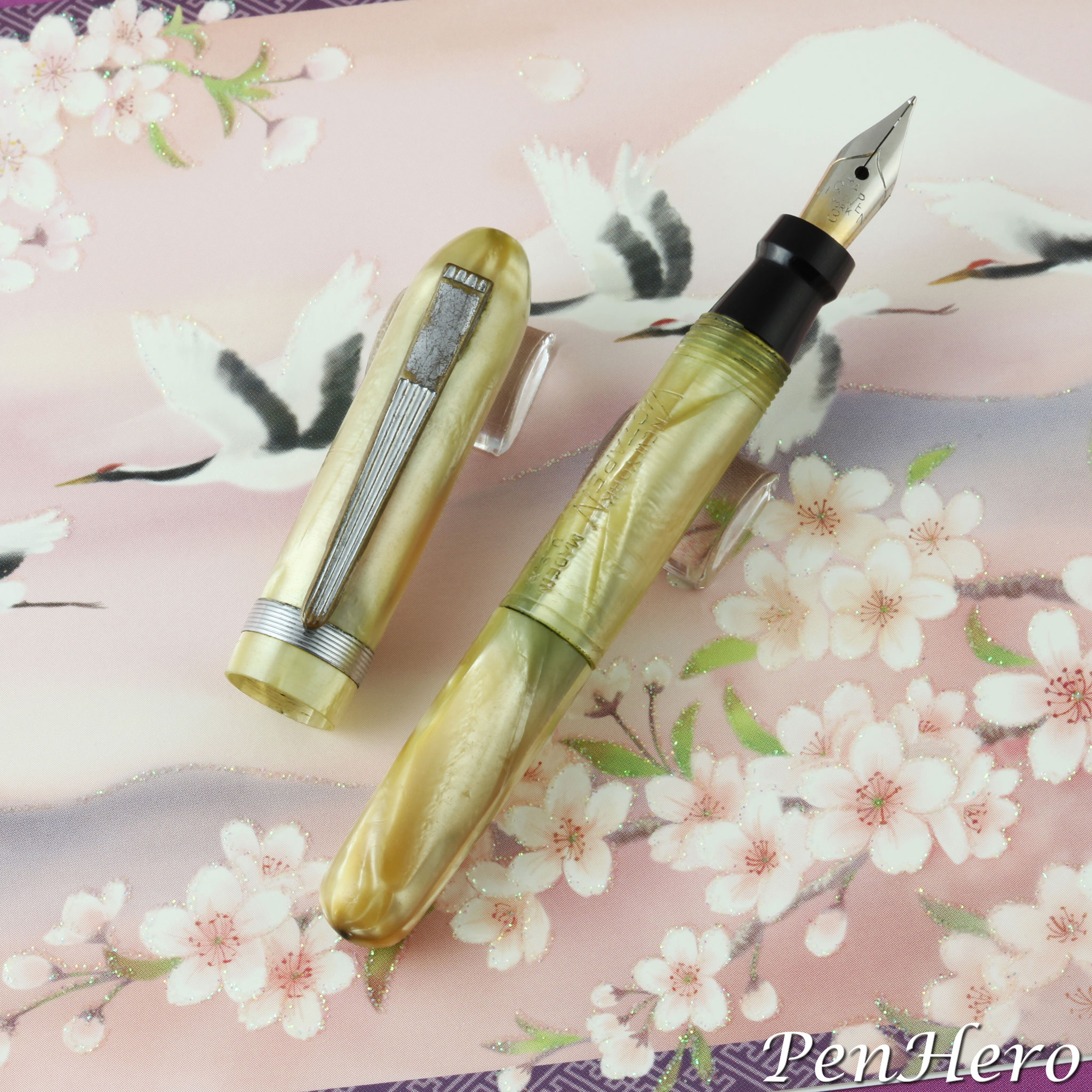 Victapen Convertible fountain pen in cream marble c. 1932-1942
Victapen Convertible fountain pen in cream marble c. 1932-1942
The company was still in business into the early 1950s as Hugetz participated as a member of the Fountain Pen and Mechanical Pencil Industry Advisory Committee under the Office of Price Stabilization, also known as the Price Stabilization Board, the federal agency whose task was to control prices during the Korean War. Parker, Sheaffer, Esterbrook, and David Kahn (Wearever) were among the many other manufacturers represented. According to the minutes of December 6, 1951, Hugetz was absent.
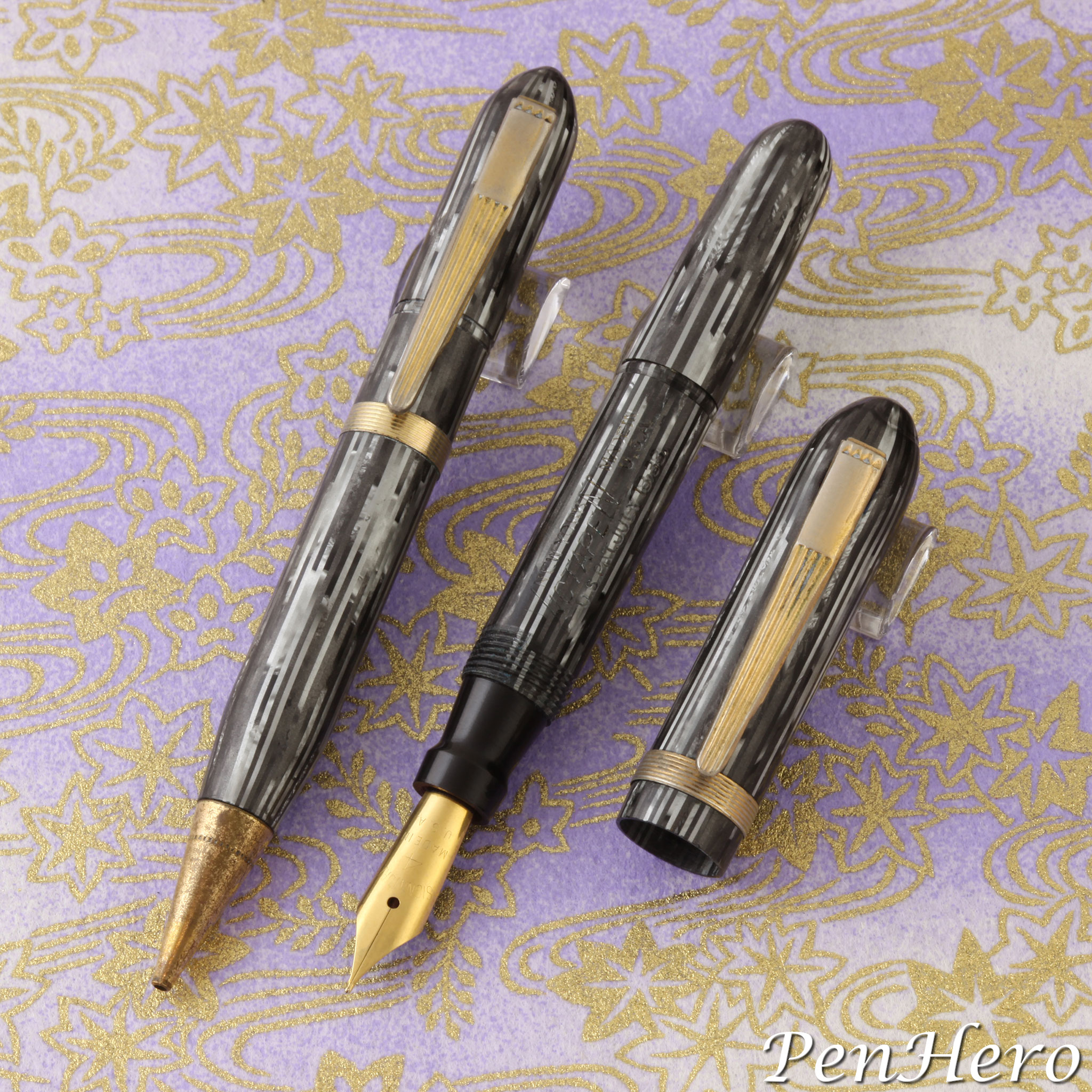 Victapen Convertible fountain pen and pencil set in gray stripe marble c. 1945-1949
Victapen Convertible fountain pen and pencil set in gray stripe marble c. 1945-1949
As none of the examples I have are in working order, I’m not going to include a performance review. These pens generally have nice fit and finish and better plating than low end pens from the period, but not at the level of the top brands. I do have a couple that still have the unusual, tapered ink sac, but they are not watertight. The few restorations I've seen are done with standard straight ink sacs. Given the very small size and quirky design, I personally seem them more as collectibles than users.
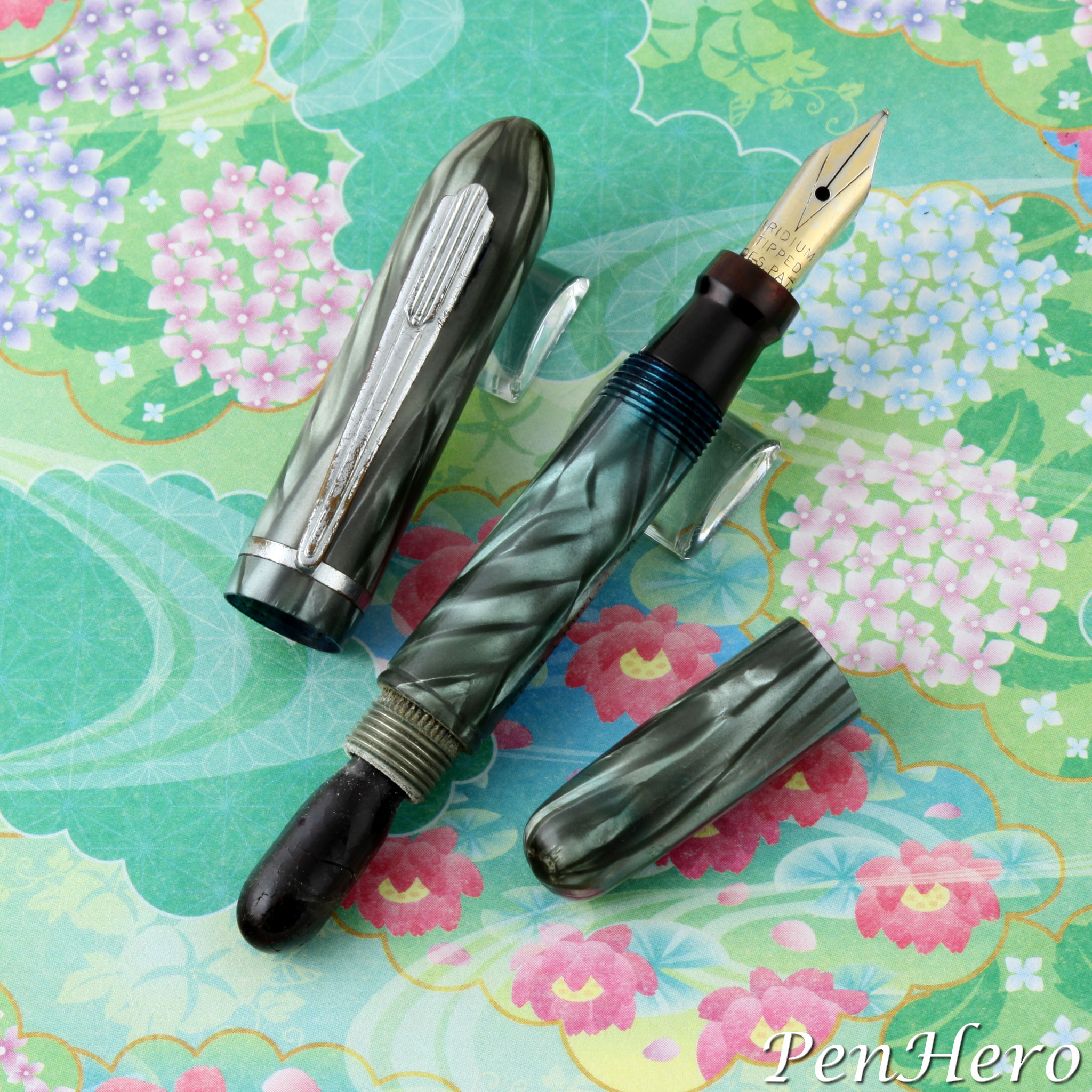 Victapen Convertible fountain pen in green marble c. 1932-1942, open showing bulb
Victapen Convertible fountain pen in green marble c. 1932-1942, open showing bulb
Victor Victapens are well-made and an interesting pen design with the convertible feature giving it added interest. They come in a variety of celluloids and clip and cap band styles. They are not common, so building a collection may take time. They don't tend to command high prices. I'm frequently encountering new ones and hope someday to see an all metal Victapen! Consider the Victor Victapen if you like collecting unusual small writing instruments!
Acknowledgement
Thanks to Will Gunadi for loaning the image of the red stripe Victapen and to Tom Joiner for loaning the image of the red marble ringtop Victapen.
Pennant Spring 2021
A version of this story appeared in the spring 2021 Pennant, the magazine of the Pen Collectors of America (PCA). You can learn more about joining the PCA and subscribing to the Pennant by clicking the link.
References
Advertisement, Boys’ Life, May 1936, page 42
Advertisement, Careta, Rio de Janeiro, Brazil, December 12, 1942, page 7
Advertisement, Jornal Das Mocas, Rio de Janeiro, Brazil, April 3, 1947, page 16
Advertisement, Jornal Das Mocas, Rio de Janeiro, Brazil, April 17, 1947, page 7
Advertisement, La Noite Ilustrada, Rio de Janeiro, Brazil, October 17, 1944, page 2
Advertisement, La Noite Ilustrada, Rio de Janeiro, Brazil, March 13, 1945, page 20
Advertisement, La Noite Ilustrada, Rio de Janeiro, Brazil, November 5, 1946, page 20
Advertisement, La Noite Ilustrada, Rio de Janeiro, Brazil, November 25, 1947, page 12
Advertisement, Mennonite Weekly Review, September 8, 1949, page 4
Advertisement, New York Daily News, December 22, 1936, page 5
“Behind the Victor” Jonathan A. Veley, June 8, 2020, © Copyright 2011-2016
"Sales Help Male" Classified Advertisement, Hartford Courant, August 27, 1933, page B6
Press Releases, United States Office of Price Stabilization, Browne-OPS-GPR-1084, December 6, 1951
Victor Convertible Sets, instruction set for Victapen, U. S. Victor Fountain Pen Company, Inc., undated, but text indicates post World War II
U. S. Patent 1,918,844, awarded July 18, 1933
United States Patent Office Trademark 583312, registered December 8, 1953
Interact
Comments on this article may be sent to the author, Jim Mamoulides


